

Wife Jetta Goudal
Queer Places:
316 N Rossmore Ave, Los Angeles, CA 90004
640
North Robertson Boulevard, Los Angeles, CA
Forest Lawn Memorial Park
Glendale, Los Angeles County, California, USA
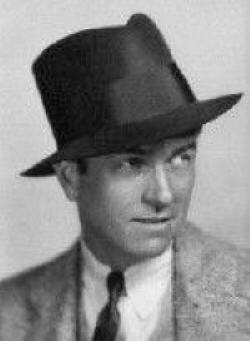 Harold
Walter Grieve (February 1, 1901 – November 3, 1993) was a motion picture art director and interior designer.
Harold
Walter Grieve (February 1, 1901 – November 3, 1993) was a motion picture art director and interior designer.
Born in Los Angeles, California, he attended Los Angeles High School then studied art at the "School of Illustration and Painting" run by John Francis Smith in Los Angeles.
In the early 1920s Grieve went to work in the film industry as a set designer and art director. He was at Metro Pictures from 1920-1923. He became one of the founding members[1] of the Academy of Motion Picture Arts and Sciences and remained active all his life in the Academy's library of historical records.
Grieve was a recent graduate of Los Angeles High School when he got a job at the old Brunton Studios in the prop department. He wanted to be an artist, but his father had insisted he'd pay only for dental school. Faced with a such a future, Grieve opted out of college altogether; the studios became his higher education. In 1920 he moved over to Metro, where he drew perspective drawings for sets. Director Rex Ingram, a man noted for his tolerance and open-mindedness, took a liking to Grieve during The Prisoner of Zenda (1922). At one point, Ingram expressed dissatisfaction with the props, expecially a box that was supposed to be very valuable in the script. The director turned past the seasoned prop men to look at the young Grieve. "You know what I'm asking for, don't you?" he asked. Grieve responded that he believed he did. Ingram nodded, "I know you do," he said. Such confidence was vindicated when Grieve returned, an antique jewel box in his hands. Ingram proclaimed it perfect for the scene. Grieve hadn't found it in the prop department, but rather in the shop of a local interior decorator, Raymond Gould. "So that kind of brushed me up for the studio," Grieve recalled, "as being one who would know what he was talking about."

Artist:
Margrethe Mather (American, 1885–1952)Title:
Jetta Goudal and Harold Grieve , 1930Medium:
platinum print, mntd
Size:
17.5 x 21.5 cm. (6.9 x 8.5 in.)

Lillian Tashman and Harold Grieve
Descriptive: (Beverly Hills)
Magrethe Mather (United States, 1885-1952)
United States, circa 1927
Photographs
Gelatin silver print
Image: 9 7/16 × 7 1/4 in. (23.97 × 18.42 cm) Primary support: 9 7/16 × 7 1/4 in. (23.97 × 18.42 cm)
Gift of David and Joyce Essex (M.84.276.3)
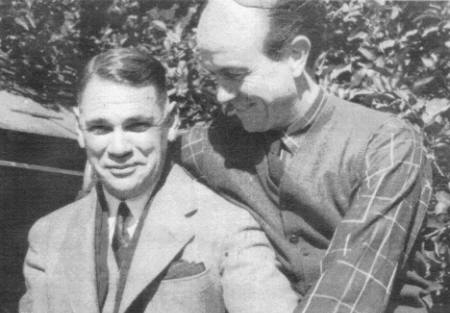
Robert Strong Woodward and Harold Grieve on the sunny balcony
of the Buckland Southwick Studio
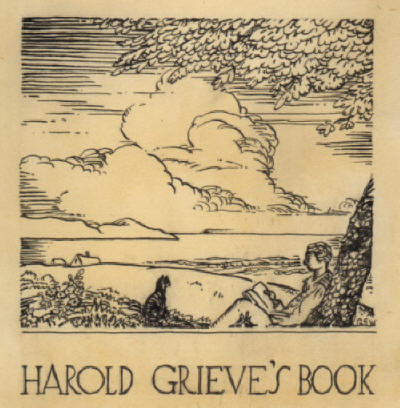
Harold Grieve Bookplate
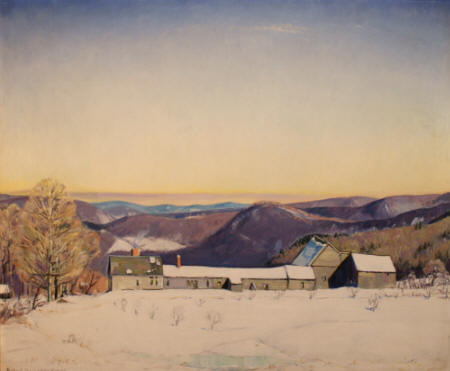
Robert Strong Woodward presented Harold Grieve with Peace and Courage, a beautiful oil painting made on Avery Road in Buckland which he took back to his Hollywood home.
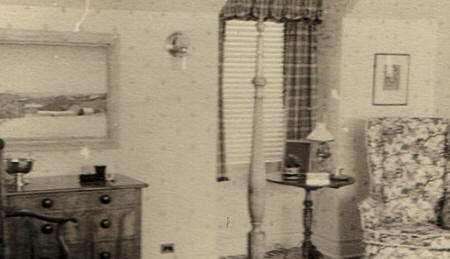
Peace and Courage hanging in the Grieve home in California. Many years later this painting came up for auction out in California. The Grieves had no children for bequeathment. It was purchased and brought home to Buckland where it is today.
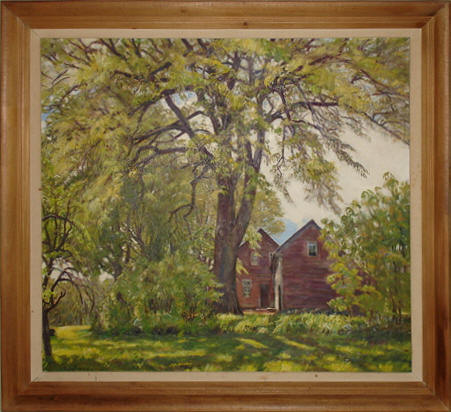
Robert Strong Woodward Diary Comments about Dooryard Elm: Painted in 1936. At my Halifax (Vt.) House. Taken by Harold Grieve from the studio in 1937 to Hollywood, California, and sold by him to Gracie Allen and George Burns of radio and movie fame for the library of their home at 720 North Maple Drive, Beverly Hills, California, which Mr. Grieve had decorated, as one of the most prominent interior decorators of the country
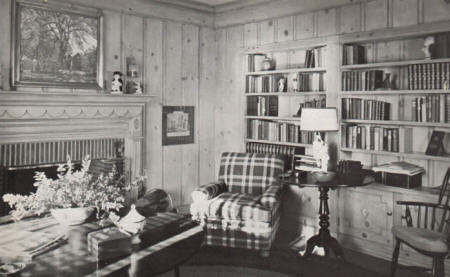
Burns' library showing the oil painting Dooryard Elm by Robert Strong Woodward.
The studio-educated Grieve would go on to construct the surrealistic sets for Alla Nazimova's Camille (1921); although credit went to Natacha Rambova, Grieve claimed much of the design was his work. ("I didn't deel hurt because all my crew, all my gang, knew who was doing what.") He faced such enforced anonymity again when Fred Niblo took over from Charles Brabin on MGM's epic Ben-Hur (1925). Although new designers were hired, Grieve's notes indicate he believed much of his work remained intact in the finished picture. He later was art and technical director at Marshall Neilan studios and took more publich acclaim for Dorothy Vernon of Haddon Hall (1924), Lady Windemer's Fan (1925), and So This Is Paris (1926), doing a mix of costumes and sets. Other movies includes: The Conquering Power (1921), The Thief of Bagdad (1924), Tess of the D'Ubervilles (1925), The Sea Wolf (1926) and The Devil Dancer (1927).
The majority of set designers in the 1920s were not gay. By the time of the "talkers," Harold Grieve recalled, he felt he no longer fit in. Grieve left the industry to go into private interior decoration. Near the beginning of the 1930s, Grieve gave up working for a film studio to set up an interior design business. In 1932 his wife, former star of the silent era Jetta Goudal, whom he married in 1930, joined him in the business.
Among other things, they designed the interior of a dream home for crooner Bing Crosby and the interior of Toujours Eblouissante, the Palm Springs estate of French opera star Lily Pons that was featured in Architectural Digest. As well, Grieve did the interior of actress Colleen Moore's famous dollhouse that toured the U.S. and which can now be seen on display at Chicago's Museum of Science and Industry. The homes he decorated include those of George Burns and Gracie Allen, Bing Crosby, Robert Z. Leonard and Gertrude Olmsted, Ernst Lubitsch, Hal Roach, Irving Thalberg and Norman Shearer, and Raoul Walsh.
Harold Grieve was a close friend of Robert Strong Woodward. They first met in the early years of Woodward making oil paintings of New England scenery. He made a bookplate for Harold while he was still working in his first studio, Redgate. Harold, by then a popular motion picture art director and interior decorator of homes in Hollywood, California, chose several "Woodwards" to be centerpieces in the living rooms of famous movie stars of the day. For example, Dooryard Elm , one of Woodward's early oil paintings of the Halifax house was selected by Harold Grieve to hang in the living room of Gracie Allen and George Burns, The Golden Slope in the home of Beulah Bondi and From a Hill Pasture in the home of Jack Benny and Mary Livingston. There were also a number of other paintings placed by Grieve but the records have been lost. It is known that probably about a dozen Woodward oils were hung in homes in the Hollywood area.
Harold and his wife, Jetta Goudal, visited the homes and studios of Robert Strong Woodward during the 1930s and 1940s. All became good friends and exchanged Christmas cards and letters. Harold frequently requested to stop during the trip to the house so he could get out to pick a browned, gone-by flower or a tree twig still hanging onto its leaves, which, on returning to the Woodward home, he arranged into a winter bouquet. The Woodward household were instructed sternly by Woodward not to touch a single flower or twig in the arrangement, which remained in the dining room for months later. Woodward considered it "God's arrangement."
Harold Grieve's wife died in 1985 in Los Angeles and he died there in 1993. They are interred together in a private room at the Great Mausoleum, Sanctuary of the Angels, at Forest Lawn Memorial Park Cemetery in Glendale, California.
My published books: